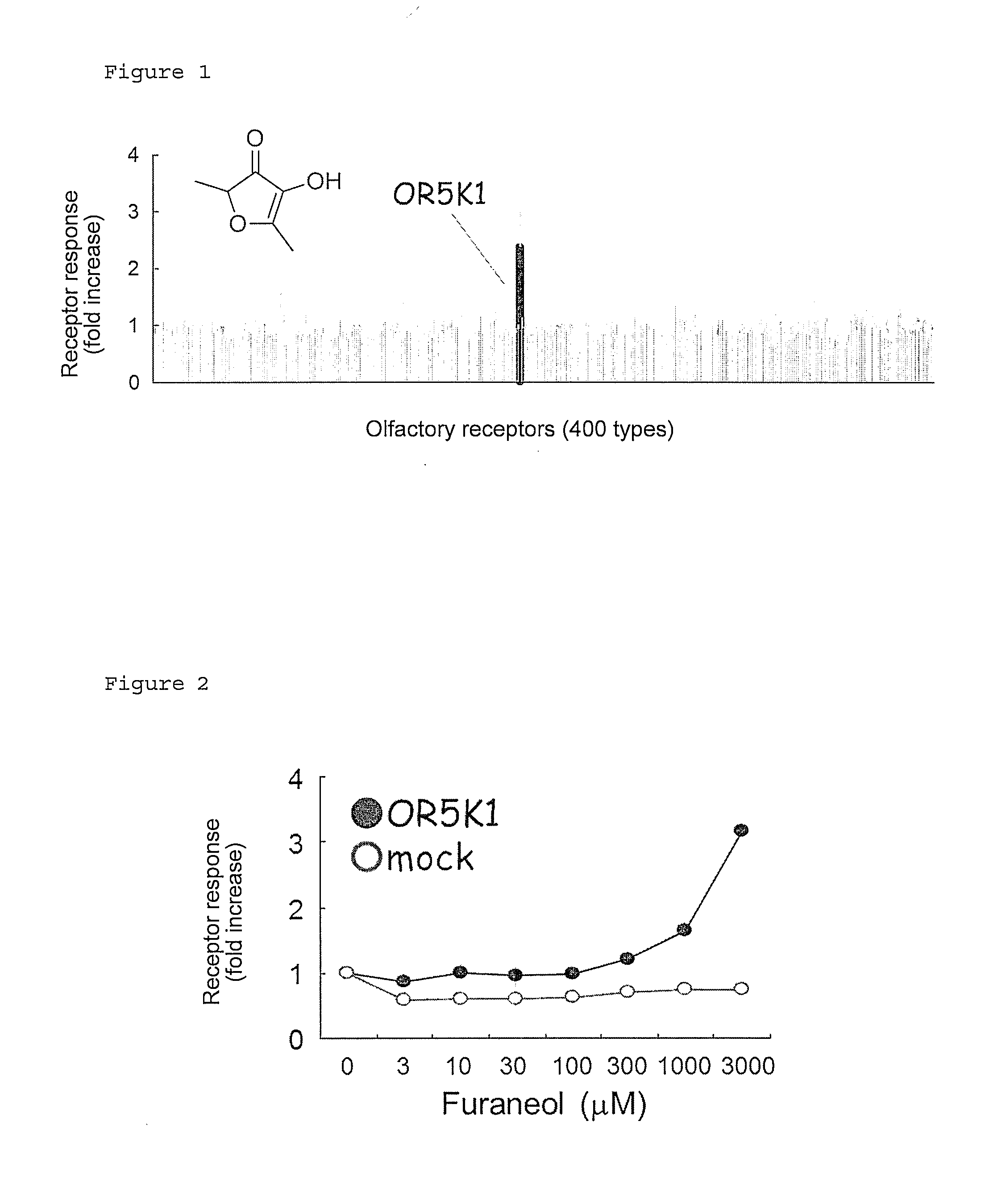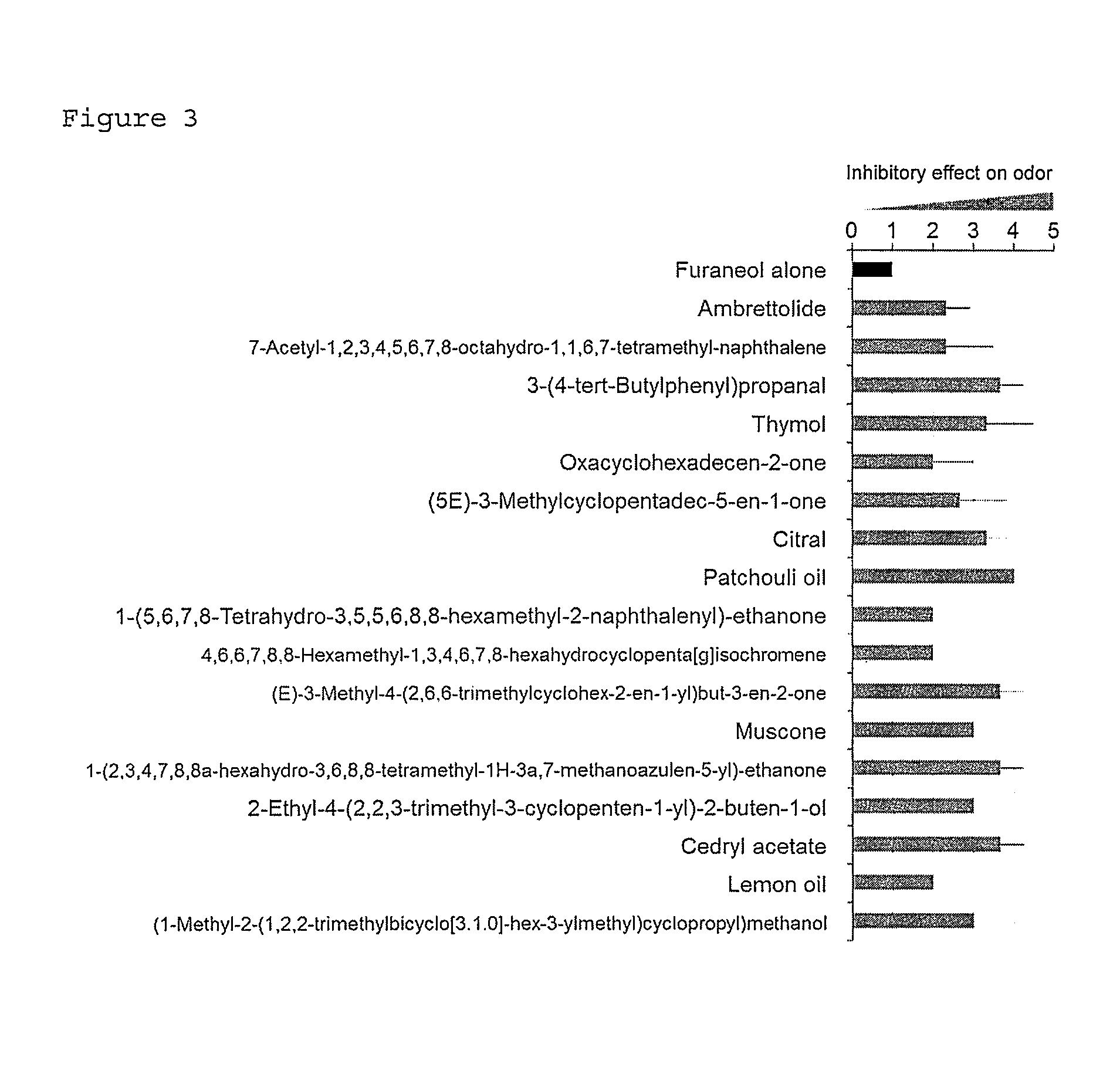Inhibitor of Odor Caused by Furaneol
a furaneol and odor technology, applied in the direction of deodorization, plant/algae/fungi/lichens, deodorizing agents, etc., can solve the problems of re-emission of bad smell, large number of malodorous molecules which cannot be dealt with by conventional deodorization methods, and the effect of masking even odors
- Summary
- Abstract
- Description
- Claims
- Application Information
AI Technical Summary
Benefits of technology
Problems solved by technology
Method used
Image
Examples
example 1
Identification of Olfactory Receptor Responding to Furaneol
1) Cloning of Human Olfactory Receptor Gene
[0067]On the basis of sequence information registered in GenBank, each human olfactory receptor gene was cloned by PCR with Human Genomic DNA Female (G1521: Promega Corp.) as a template. Each gene thus amplified by PCR was inserted into a pENTR vector (Invitrogen Corp.) according to the manual. A NotI-AscI site present on the pENTR vector was recombined into a NotI-AscI site prepared downstream of a Flag-Rho tag sequence on a pME18S vector.
2) Preparation of pME18S-Human RTP1S Vector
[0068]A gene (GenBank GI: 50234917) encoding a human receptor transporting protein, RTP1S was inserted into the EcoRI-XhoI site of the pME18S vector.
3) Preparation of Olfactory Receptor-Expressing Cell
[0069]HEK293 cells expressing each of 400 types of human olfactory receptors were prepared. Each reaction solution having the composition shown in Table 2 was prepared, then left standing for 15 minutes in a...
example 2
Concentration-Dependent Response of OR5K1 to Furaneol
[0073]The olfactory receptor OR5K1 (GenBank GI: 115270955, SEQ ID NO: 2) was expressed, together with human RTP1S, on HEK293 cells by the same procedures as in Example 1 and then examined for the concentration dependence of its response to varying concentrations of Furaneol (0, 3, 10, 30, 100, 300, 1000, and 3000 μM). As a result, OR5K1 exhibited a concentration-dependent response to Furaneol (FIG. 2).
example 3
Identification of OR5K1 Antagonist
[0074]84 types of test substances were examined for their antagonistic activity against the response of the olfactory receptor OR5K1 to Furaneol.
[0075]Furaneol (3 mM) and each test substance (100 μM) were added to HEK293 cells allowed to express the olfactory receptor OR5K1 by the same procedures as in Example 2. The response of the olfactory receptor was measured to evaluate change in receptor response caused by the addition of the test substance.
[0076]The rate of inhibition of the receptor response by the test substance was calculated as follows: firefly luciferase-derived luminescence intensity (Y) in the olfactory receptor OR5K1-expressing cells without Furaneol stimulation was subtracted from luminescence intensity (X) induced by stimulation with Furaneol alone to determine receptor activity (X−Y) based on the stimulation with Furaneol alone. Likewise, the luminescence intensity (Y) in the cells without Furaneol stimulation was subtracted from ...
PUM
| Property | Measurement | Unit |
|---|---|---|
| size | aaaaa | aaaaa |
| polarity | aaaaa | aaaaa |
| molecular weight | aaaaa | aaaaa |
Abstract
Description
Claims
Application Information
 Login to View More
Login to View More - R&D
- Intellectual Property
- Life Sciences
- Materials
- Tech Scout
- Unparalleled Data Quality
- Higher Quality Content
- 60% Fewer Hallucinations
Browse by: Latest US Patents, China's latest patents, Technical Efficacy Thesaurus, Application Domain, Technology Topic, Popular Technical Reports.
© 2025 PatSnap. All rights reserved.Legal|Privacy policy|Modern Slavery Act Transparency Statement|Sitemap|About US| Contact US: help@patsnap.com


